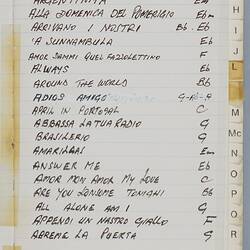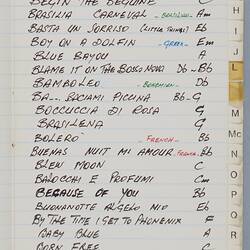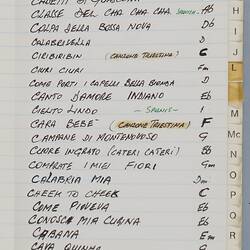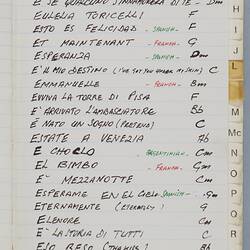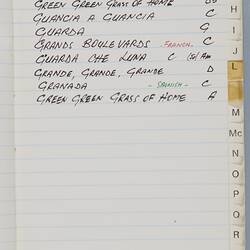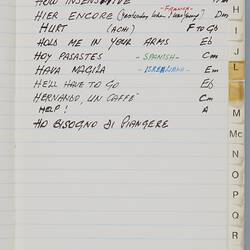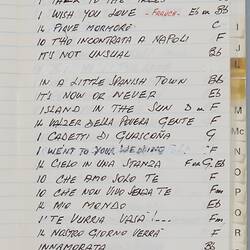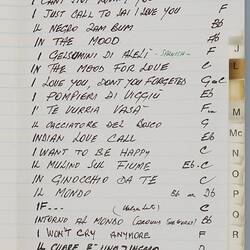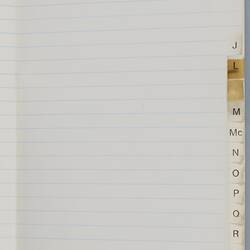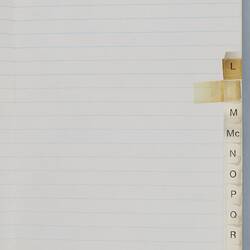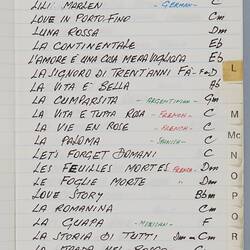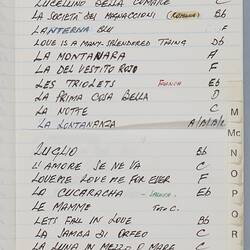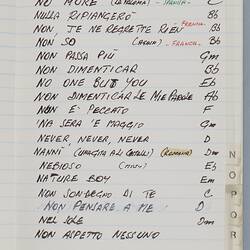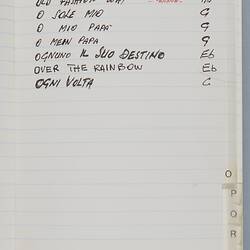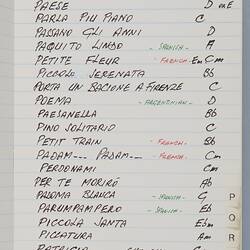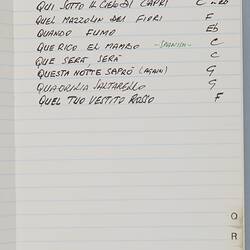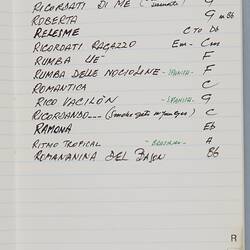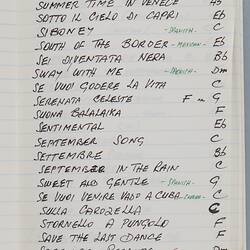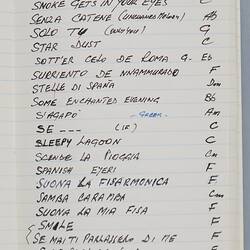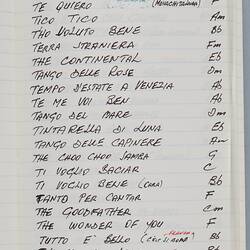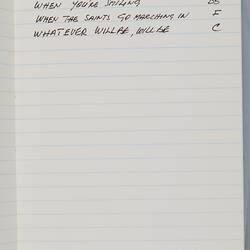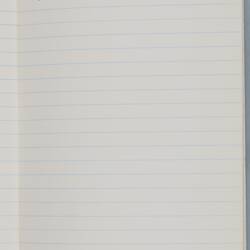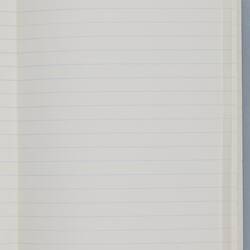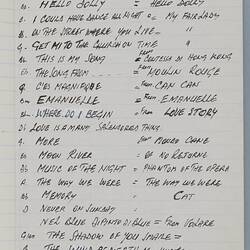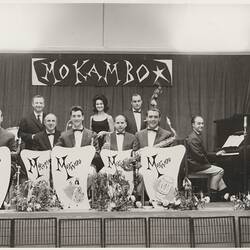Summary
Songbook listing songs which were part of the Mokambo Orchestra repertoire from 1950s until the1990s, in alphabetical order. The languages include Greek, Spanish, Italian, German, French and English. Style and origin of songs include Maltese, Mexican, Latin-American, Bohemian and Cuban. The last page of the songbook features a collection of well-known songs from film soundtracks.
It is part of a collection of over 50 pieces which includes a button accordion, seven music stands, posters, scrapbooks, and digital photographs.
Ugo Ceresoli (1927-1996) emigrated from Italy to Australia, arriving in Melbourne in late 1952 on the 'Oceania'. Ugo was 25 years old and was an accomplished dance musician and accordionist. Reunited in Melbourne with his brother Bruno, they formed an Italian music band in Carlton, an inner suburb of Melbourne amidst a growing post-War Italian migrant community. In about 1953 they named their dance band 'Mokamba Orchestra' and performed Italian and Latin and other music styles for increasingly cross-cultural Melbourne audiences. They also appeared on radio and TV. Bruno died in 1970, but Ugo, joined by his wife Jo Muhrer (Laurance), a singer, continued perforrming with Mokambo Orchestra for over 40 years.
Physical Description
Green 'Collins' [brand] songbook, comprising of double-sided lined pages with alphabetically organised sections. The book features a black plastic-covered spine and contains handwritten song titles, in alphabetical order. The songs are mainly written in black ink, however, there are many added words outlining the nationality/language of individual songs, written in green, red and blue ink.
Significance
Statement of Historical Significance:
The Ugo Ceresoli and Mokambo Orchestra Collection documents the rising popularity of Italian-Latino music following mass Italian migration to Australia post-World War II. The collection provides invaluable insights into the experiences of those who migrated from Italy when faced with political, social and economic uncertainty in their country and a demand for white European labour in Australia.
While representing a post World War II migrant narrative of two young men from Italy settling in Carlton, it also explores broader themes of the establishment of a Carlton Italian community; the forging of small businesses in the 1950s and 1960s; and the thriving music and entertainment scene in Melbourne. The formation of numerous 'Italian-Latino' bands playing ballo italiano music led to this style being popular with both Italian communities and the broader public, contributing to an increasing admiration for Italian culture. The Mokambo Orchestra and its associated activities covers a period of over thirty years and was an integral part of the growing Italian community within inner Melbourne.
The collection comprises over 50 items donated by the Ceresoli family which have extensive research potential. It includes photographs, scrapbooks, newspaper articles, personal correspondence, a songbook, as well as one of Ugo Ceresoli's accordions and several of the orchestra's music stands. The collection is of broad social and political significance and reflects Australia's widening national identity. Many items in the Ugo Ceresoli and Mokambo Orchestra Collection are well provenanced to other well-known Italian-Latino bands, Italian musicians and other heritage collections, most notably the Italian Historical Society CO.AS.IT collection in Melbourne.
More Information
-
Collection Names
-
Collecting Areas
-
Acquisition Information
Donation from Ms Melinda Ceresoli, 03 Oct 2013
-
Past Owner & User
Mr Ugo Ceresoli, 230 Palmerston Street, Carlton, Melbourne, Victoria, Australia, 1950-1995
-
Past Owner & User
Mr Bruno Ceresoli, 230 Palmerston Street, Carlton, Melbourne, Victoria, Australia, 1950s-1990s
-
Performer
Mokambo Orchestra, Carlton, Melbourne, Victoria, Australia, 1950s-1990s
-
Inscriptions
Handwritten inscription [black ink] on front reads: 'PRE_MEMORIA / DI CANZONIETITOLI / REPERTORIO / INTERNAZIONALE / 1915 - 1995'. Logo on front of book reads: 'COLLINS'.
-
Classification
Recreation & tourism, Performing arts - ensembles, Musicians
-
Category
-
Discipline
-
Type of item
-
Dimensions
332 mm (Length), 142 mm (Width)
-
Keywords
Entertainment Industry, Entertainment Venues, Entertainment Workers, Performances, Performers, Performing Arts, Music Band, Music Performances, Singing, Italian Communities



